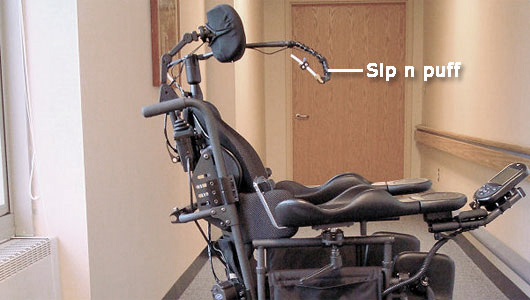Overview of the “sip n puff” interface for educators of students with diverse needs
What is it?
The “sip n puff” interface is a unique input method for individuals with limited mobility that interprets a user’s breath (inhaling and exhaling) using a sensor connected to a tube held in the user’s mouth. By inhaling (sipping) or exhaling (puffing) through the tube, the user can trigger various actions to occur on a computer or a wheelchair.
Compared to other types of assistive technology, the sip n puff is relatively simple and is something that many individuals can make use of. However, like other types of assistive technology, they are very expensive (hundreds or thousands of dollars) and require awkward, often obsolete hardware interfaces (like serial ports) and restrictive software that cannot be modified. Using open-source hardware and software, I believe the technology is completely within grasp and ready for some fresh perspective!
What can I use it for?
Today, sip n puff interfaces are common for controlling motorized wheelchairs (puff to move forward, sip to move back, etc.), but there is no reason why those electrical signals couldn’t be used as input for a personal computer.
Typically, the sip n puff interface is used as a “digital” interface, meaning it us used for simple “on” or “off” operations. However, the actual sensor that is used in these systems is capable of reading “analog” input, which let’s the user vary the amount of pressure they are exerting for different effects. With this in mind, here are just a few example uses I can think of right now:
- Hands-free operation of mouse operations like left click and right click.
 Expressive control over variables relevant to the task at hand, like varying the width of the paint brush strokes while drawing.
Expressive control over variables relevant to the task at hand, like varying the width of the paint brush strokes while drawing.- Basic communication with individuals who may have trouble with speech, but can control their breath easily.
- Hands-free interaction with electronics or software projects (I’ll make sure it’s compatible with fun software like Scratch and Processing!)
When paired with another interface (like the Eyewriter eye tracking system or the MaKey MaKey), even more natural expression would be possible. For example, as a user moves the mouse cursor with their eye movements (Eyewriter), they could use the sip-n-puff to alter the intensity of the color they are using.
Can I buy one and start playing around?
There are commercial sip and puff interfaces out there today, but they are all very expensive (hundreds to thousands of dollars) and may be hard to figure out. Many are used for directly controlling wheelchairs, while others are quite difficult to pair with a computer and make use of.
Over the next few months I will be developing a simpler sip-n-puff interface that can be easily configured to act like a USB keyboard or mouse to perform common actions on your computer without any special software or quirky installation. This has been done by at least one other person on the web, but documentation is very scarce and the source files seem to have evaporated over time. I plan to design and release an open-source sip and puff interface that can be built for <$50.
What needs to be done?
To create a sip-n-puff that is useful, cheap and easy to use will need a little bit of work, but I’m excited to get started! Right now, here is the work that I am planning on doing:
- Design and fabricate both a standalone version and an Arduino shield to provide users with different levels of expertise to use the interface. This will entail creating (and open-sourcing) schematics and PCB layouts for each, then using a fab house to produce and test several rounds of prototypes.
- Create a body of simple documentation for both educators and developers to understand the system and use it in curricular contexts. This will include videos, tutorials and lesson plans.
- Build a 3D-printable enclosure to give the system a little more durability.
I will be working on this project throughout the year and sharing all of the design files in a variety of ways. Here are some places to check:
- Source code, circuit board designs and bills of materials will be posted on Github
- Documentation will be posted in a variety of formats, including articles on this blog, step-by-step walkthroughs on Instructables and videos on Vimeo.
- Any 3D-printable design files will be posted through Thingiverse.
- Lots of photos on my Flickr photostream.
